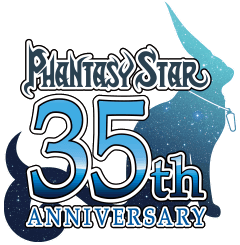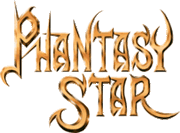Phantasy Star Wiki has a more detailed article located here.
|

|

Phantasy Star logo
Phantasy Star (Japanese: ファンタシースター) is a RPG video game series by Sega, similar to Final Fantasy. The series was highly praised and was extremely innovative when it was released to the Sega Master System in the late eighties. It also used turn based battling based upon random encounters in the earlier games, also used in games like Final Fantasy and Pokemon. It started as a traditional single player game series, but has progressed into an MMORPG series. Unlike many other console role-playing games, it has a science fantasy setting where the player battles monsters using a variety of guns in addition to the staple of melee weapons and magic that are found in other RPGs, and now uses real-time combat and a 3-D engine.
History[]
The original Phantasy Star was released for the Sega Master System in Japan on December 20, 1987. It was one of the first cartridges to include battery backed RAM for saving game positions. The game featured 3D maze-like dungeons, which players traversed in a first-person mode. Phantasy Star, along with Dragon Quest and Final Fantasy, distinguished itself as a pioneer of what came to be defined console role-playing.
The series is noteworthy in that all of its games take place in the same universe, as opposed to many RPG series such as Final Fantasy, wherein successive game settings are unrelated, or, at most, superficially related. Each major Phantasy Star game adds onto the series' overall story, culminating in Phantasy Star IV which ties all of the series' plot elements together into a final, epic conclusion.
Both Phantasy Star Online and Phantasy Star Universe are their own series based on the original Phantasy Star games. They continue the theme of a persistent game universe, but are set in different planetary systems than the original games.
Games[]
Algol series (Main)[]
- Phantasy Star (Sega Master System, 1987/Sega Mega Drive, 1992)
- Phantasy Star II (Sega Mega Drive/Genesis, PC (RealArcade) 1989).
- Phantasy Star II: Shilka's Adventure (Sega Meganet modem, 1991)
- Phantasy Star II: Amia's Adventure (Sega Meganet modem, 1991)
- Phantasy Star II: Huey's Adventure (Sega Meganet modem, 1991)
- Phantasy Star II: Eusis' Adventure (Sega Meganet modem, 1991)
- Phantasy Star II: Nei's Adventure (Sega Meganet modem, 1991)
- Phantasy Star II: Rudger's Adventure (Sega Meganet modem, 1991)
- Phantasy Star II: Kainz's Adventure (Sega Meganet modem, 1991)
- Phantasy Star II: Anne's Adventure (Sega Meganet modem, 1991)
- Phantasy Star III: Generations of Doom (Mega Drive/Genesis, 1991)
- Phantasy Star Adventure (Japanese Game Gear, 1992)
- Phantasy Star Gaiden (Japanese Game Gear, 1992)
- Phantasy Star IV: The End of the Millennium (Mega Drive/Genesis, 1994)
Ragol series (Online)[]
- Phantasy Star Online (Dreamcast, PC, 2001)
- Phantasy Star Online ver.2 (Dreamcast, 2002)
- Phantasy Star Online: Episode I & II (GameCube, Xbox, 2002)
- Phantasy Star Online: Episode III: C.A.R.D. Revolution (Nintendo GameCube, 2004)
- Phantasy Star Online Episode I & II Plus (Nintendo Gamecube, 2004)
- Phantasy Star Online: Blue Burst (PC, 2004)
Gurhal series (Universe)[]
- Phantasy Star Universe (PC, PlayStation 2, Xbox 360) 2006 (Japan & North America)
- Phantasy Star Universe: Ambition of the Illuminus (PC, PlayStation 2, Xbox 360, 2007 — expansion pack)
- Phantasy Star Portable (PlayStation Portable) 2008
- Phantasy Star Portable 2 (PlayStation Portable) 2010
- Phantasy Star Portable 2 Infinity (PlayStation Portable — expansion pack) 2011
Phantasy Star Online 2 series[]
- Phantasy Star Online 2
- Phantasy Star Online 2 es
- Phantasy Star Online 2: New Genesis
- Phantasy Star Nova
- Idola: Phantasy Star Saga
Remakes and compilations[]
- Phantasy Star Collection (Japanese Sega Saturn, 1998).
- Phantasy Star Collection (Game Boy Advance, 2002)
- Phantasy Star Generation 1 (PlayStation 2, 2003 Japan)
- Phantasy Star Generation 1 is a remake of the original Phantasy Star.
- Phantasy Star Generation 2 (Playstation 2, 2005, released only in Japan)
- Phantasy Star Generation 2 is a remake of the original Phantasy Star II.
- Phantasy Star Complete Collection (PlayStation 2) 2008 (Japan only)
Prevailing themes[]
The plot, setting and themes of the Phantasy Star series vary dramatically from the franchise's early installments to the multiplayer titles of today. Phantasy Star, Phantasy Star II, and Phantasy Star IV all deal with the concept of evil as a living, sentient entity that takes an active interest in galactic events.
The Dark Force (Romanized to Dark Falz in early American versions of the original Phantasy Star) seems to have chosen the Algol star system as its particular plaything, returning every thousand years to wreak havoc. These visits tend to result in loss of life on a massive scale, and often correspond with the rise of totalitarianism in the typically-democratic stellar government of the system. It would seem that Dark Force prefers to work its villainy through an unconnected third party - the once-benevolent King Lassic in Phantasy Star, for example, and the all-controlling supercomputer Mother Brain in Phantasy Star II. Dark Force does not reveal itself until its chosen provocateur has either been eliminated or is no longer useful as a cat's-paw. The results of Dark Force's visits are invariably catastrophic for the people of Algol, most notably in Phantasy Star II, when its activities contributed directly to the destruction of Palma, the Algol system's largest and most ecologically lush planet.
Given Dark Force's 1,000-year cycle time, the heroes of each game presumably go to their graves believing that they have eliminated this entity. Dark Force's defeat typically ushers in a period of recovery and prosperity for the Algol system, which over the centuries devolves into a sort of self-deceptive indolence - the people blithely ignoring the warning signs of Lassic's madness, for example, or the abject unwillingness of the populace to accept the possibility that Mother Brain is malfunctioning. It is around this time that Dark Force reappears to terrorize the system from the shadows.
Phantasy Star III, while including Dark Force as the principal villain, was neither set on Algol nor dependent on that system's mythology. It is widely considered to be the weakest of the first four titles.
Game scholars have devoted considerable discussion to the philosophical relevance of a game anthropomorphizing the concept of evil as a physical entity rather than embodied in a morally reprehensible - but still concrete - individual. While it is hardly uncommon for video-games, particularly fantasy role-playing games, to deal with the conflict between good and evil, it is extremely rare (if not unique) to see Evil incarnate rather than represented by some being or individual who behaves in an evil way. Thus the early Phantasy Star series reflects on the battle of good versus evil from an unusual perspective, and with surprising thematic intensity. Whether this level of depth was part of the designers' original intent for the series is unknown, though it is likely that the concept grew organically with the game series itself. In the highly unpredictable world of video-game development, it is uncommon for designers to plan far beyond the first installment of a game. Once a title becomes successful and a franchise is assured, those designers tend to cherry-pick the most effective aspects for future installments.
Beyond Phantasy Star IV, the series underwent a massive transformation as SEGA determined that this franchise would be ideal for multiplayer environments. The visual style of later Phantasy Star games match the earlier ones, but much of the series' thematic focus is gone, simply because in multiplayer environments, it is human players - not game stories - that fuel emotional relevance.
Universe[]
Algol Star System[]
The Algol star system is the setting of the series. It has four planets — Palma, Motavia, Dezoris, and Rykros — as well as many orbital space stations. The planet names are sometimes spelled differently from game to game.
Palma/Palm/Parma[]
Palma is a green planet, and apparently the original homeworld of the Palmans, Algol's most widespread species. Palma is the center of the Algol system's government until AW 1284, when the space satellite Gaira malfunctions and causes the planet's destruction during the events of Phantasy Star II. The "humans" seen in the series are actually Palmans who have migrated to Motavia, terraforming it to be livable.
Motavia/Motabia/Mota[]
Motavia was originally a desert planet, but it was radically transformed by extensive forestation and irrigation. In Phantasy Star II, the planet is green, and water is abundant thanks to the Mother Brain and the Climatrol Center, but it returns to its former desiccated state in the fourth game.
Motavia is inhabited by indigenous Motavians, owl-like intelligent humanoids with blue feathers, as well as refugees from Palma.
Dezoris/Dezolis/Dezo[]
Dezoris is an ice planet populated by green-skinned intelligent humanoids, and yellow, talking Musk Cats. Because of the planet's harsh environment and dangerous native creatures, very few Palmans and Motavians live on the planet; it is for this reason that the Espers live here in the hidden Esper Mansion.
Rykros/Ryucross[]
Rykros is a mysterious planet on an extremely elongated orbit, such that it only approaches the other planets once every 1,000 years. It may only be seen by looking through the Aeroprism, and its exact location is unknown to any living being.
External links[]
- Phantasy Star Cave Complete Phantasy Star fan site with guides and a wide community.
- The Phantasy Star Pages Comprehensive Phantasy Star page.
- Interview with Rieko Kodama, Creator of Phantasy Stars I, II, and IV
- PSO Planet — News site
- History of the Phantasy Star series Sega-16's complete retrospective on the series.
- Phantasy Star series Manuals
- History of Phantasy Star
- Phantasy Star Wiki A Wiki project chronicling all things Phantasy Star — from the original series to the newly-released Phantasy Star Universe.
- Ephinea A place for players to continue playing Phantasy Star Online
